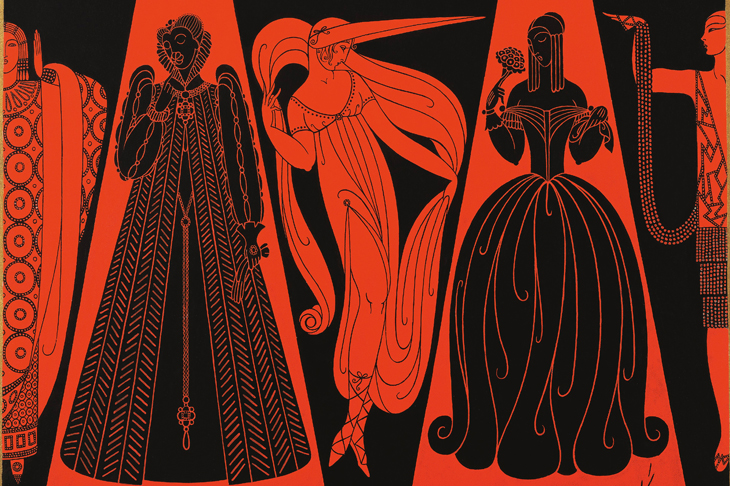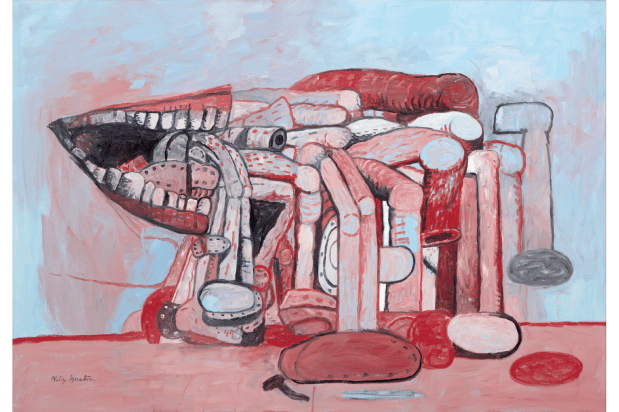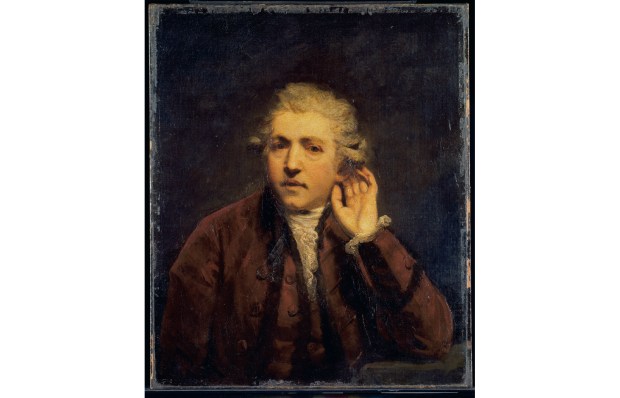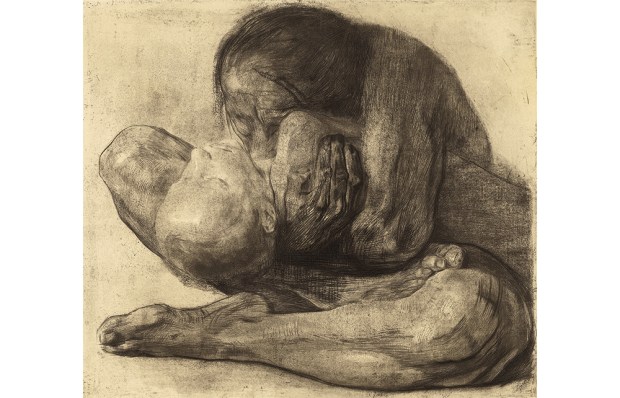Erté was destined for the imperial navy. Failing that, the army. His father and uncle had been navy men. There were painters and sculptors on his mother’s side, but they were thought very frivolous. Romain de Tirtoff (‘Erté’ came from the French pronunciation of his initials) was born in 1892 at the St Petersburg Naval School where his father Pyotr was inspector. When he was a little boy, his aunt bought him a set of wooden soldiers. Instinctively, he hated war, violence and, above all, uniforms. He burst into tears and threw the box out of the window.
What he liked best was to play with his mother’s old perfume bottles, which he dressed in scraps of lace to make ballerinas. That is what Erté did for the rest of his long and productive life until his death in 1990, aged 97. He created wonderful, wild, impossible costumes for fantasy figures. His heroines were femmes fatales, black widows, courtesans and vengeful goddesses. He designed for Cleopatra, Nefertiti, Scheherazade, Salome, Messalina, Helen of Troy, Hera, Diana, Circe; for sphinxes and sleeping beauties. He invented a pantheon of mythological and symbolic figures, personifications of the letters of the alphabet, the seasons, star signs, numbers, jewels and the seven deadly sins. Sloth reclines on a pile of tasselled cushions and kicks off her slippers. Erté called one of his series simply ‘The Diva Suite’.
He was apprenticed to the great couturier Paul Poiret and contributed more than 2,500 drawings to Harper’s Bazaar over 20 years — 240 of them made the cover. He dreamt up costumes for the stage, the opera, the ballet, for Broadway and Hollywood, the West End and the Folies Bergère. He styled shop windows and designed playing cards. The Ace of Clubs wears a black leotard and balloon sleeves embroidered with pearls. He sketched costumes for Mata Hari and Anna Pavlova and ‘onion’ and ‘potato’ outfits for a ‘Vegetable Ballet’. Never was there such a seductive spud.
The Mata Hari costume is a highlight of the Erté retrospective at the Grosvenor Gallery in London, celebrating the 125th anniversary of the artist’s birth. His critical reputation waxes and wanes. As a fashion illustrator, he is adored. As an artist, he is thought lightweight, a designer of gossamer froth and fribbles. His biographer Charles Spencer wrote of attempts in previous exhibition catalogues ‘to dispel the vulgar taint of printer’s ink or grease paint’.
Might Erté’s diminished reputation also be a question of upbringing? Erté never starved in a garret, nor suffered cruel neglect. He was not tortured by his sexuality. ‘I wasted very little energy in trying to fight my own nature, even less in punishing myself with feelings of guilt.’ He lived devotedly for many years with Prince Nicolas Ouroussoff and a succession of Persian cats.
Erté’s parents were fond; his childhood, in a loyalist, aristocratic family, happy. (They had a bad time of it, though, in the revolution.) His mother took him shopping in the dress shops of Nevsky Prospekt and lent him her copies of Damsky Mir — the Lady’s World. The family had a box at the Mikhailovsky. Erté and his sister Natalia ate chocolates and marzipans during the intervals. He copied Indian and Persian miniatures from books in his father’s study and Greek vase figures in the Hermitage Museum.
He was brought up by a Russian nurse, an English nanny — ‘No, she didn’t make me eat porridge, she was much too kind’ — and French and German governesses. The only misery of his childhood was being sent to a school with an all-black uniform: ‘particularly traumatic for someone accustomed to Little Lord Fauntleroy velvet suits, a jaunty feather in his beret and, later, dashing black, white or grey Toherkess [Circassian] costumes with matching fur hats in astrakhan or lamb.’ He never warmed to Coco Chanel who he thought had only created a more expensive sort of uniform: ‘enveloping women in decorated sacks’.
When the moment came to tell his father that he wanted to go to Paris, not to sea, Pyotr sighed and signed the visa. Erté set off by train from St Petersburg in January 1912, aged 19: ‘The future seemed like a gaily-coloured rainbow, bright with hope, despite the fact that it was 28 degrees below zero.’
In Paris he took cheap rooms at a maison de passe, where beds were rented by the hour. He didn’t bother the girls, and they didn’t trouble him. He spent every rouble he had on tickets to the ballet — attending first nights of Debussy’s Prélude à l’après-midi d’un faune and Stravinsky’s Le Sacre du printemps — and lived off hot roast chestnuts. Once a week he went to the Bouillon Duval for beef pot-au-feu.
He sketched the fashions worn by chic Parisiennes and sent them to the editor of Damsky Mir. He was a ‘street-style snapper’ long before Scott Schuman. His first contributions to Harper’s Bazaar made him a star. He bought a villa in Monte Carlo and wrote a monthly letter to readers about the comings and goings of Princess Pauline, Countess Anna, King Gustav, the ex-Empress Eugénie and the Shah of Persia.
He received the press in his pyjamas. ‘A boudoir costume of grey crêpe de chine trousers and blouse with narrow rose-coloured borders,’ reported the New York Sun. ‘A gorgeous crimson and black brocaded coat over his pyjamas of pongee,’ wrote the Brooklyn Daily Eagle. We hear what he wore, not what he said. It is difficult to get a sense of Erté the man, beneath Erté the clothes horse. He was proud to have been the first costumier to make an outfit entirely from lamé, worn to a fancy-dress ball, with a silk chiffon cape and a silver helmet crested with plumes. ‘My arrival caused a sensation.’
He was ‘gender fluid’ before anyone thought to call it such. The last Erté exhibition at the Grosvenor Gallery was in1967, when the Rolling Stones wore silk scarves, and Twiggy modelled three-piece trouser suits. The time is right for another revival: Erté as new hero for our gender-anxious times.
His costumes, so irresistible, so icily sexy on the page, never look quite so good on. Photographs of dancers in his designs fall short of the sketched fantasy, real women being so tediously short, or bosomy, with hips that spoil la ligne. But as flights of imagination, escapes into a dream world of Mélisandes and Aphrodites, Eves and Delilahs, Erté’s sketches cannot be bettered.
In October 1917, Harper’s Bazaar praised their star artist: ‘To glance at an Erté design is amusing. To look at one is interesting. To study one is absorbing.’ To wear one? Impossible.
Got something to add? Join the discussion and comment below.
Get 10 issues for just $10
Subscribe to The Spectator Australia today for the next 10 magazine issues, plus full online access, for just $10.
You might disagree with half of it, but you’ll enjoy reading all of it. Try your first month for free, then just $2 a week for the remainder of your first year.















Comments
Don't miss out
Join the conversation with other Spectator Australia readers. Subscribe to leave a comment.
SUBSCRIBEAlready a subscriber? Log in